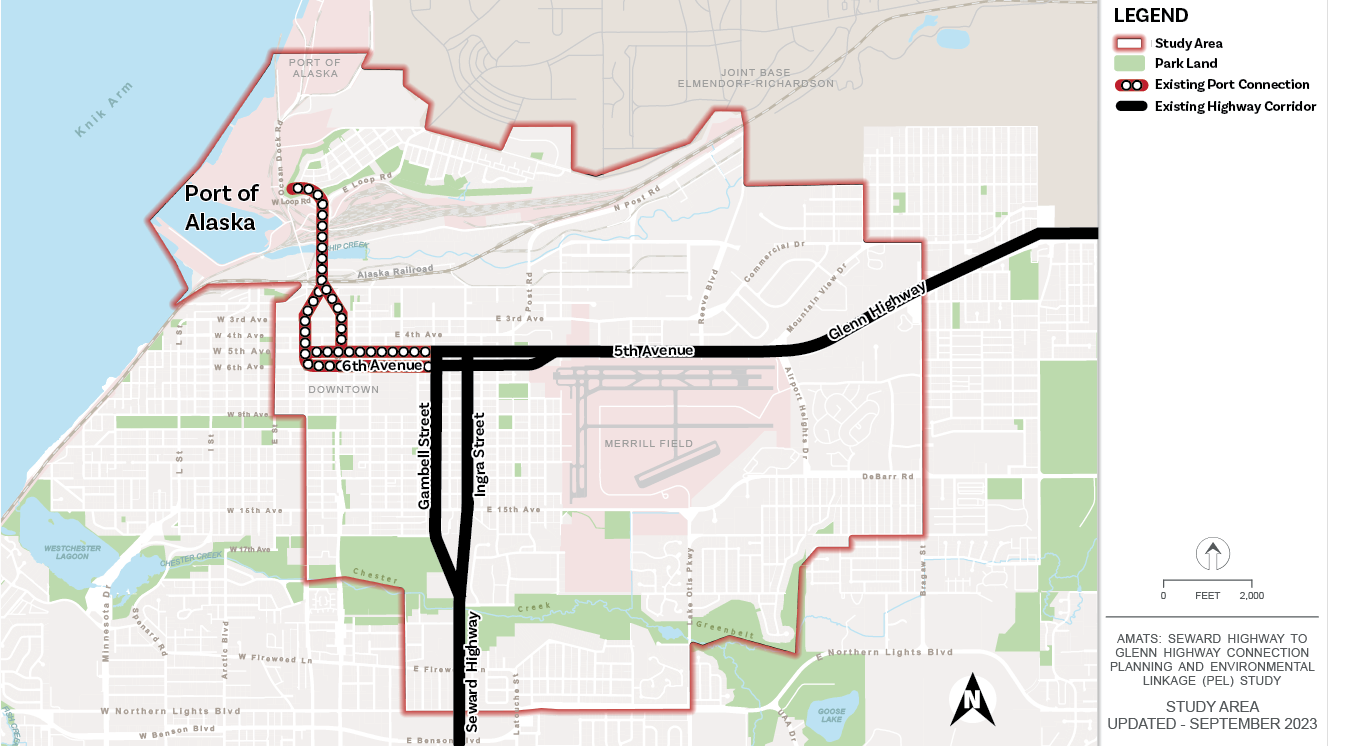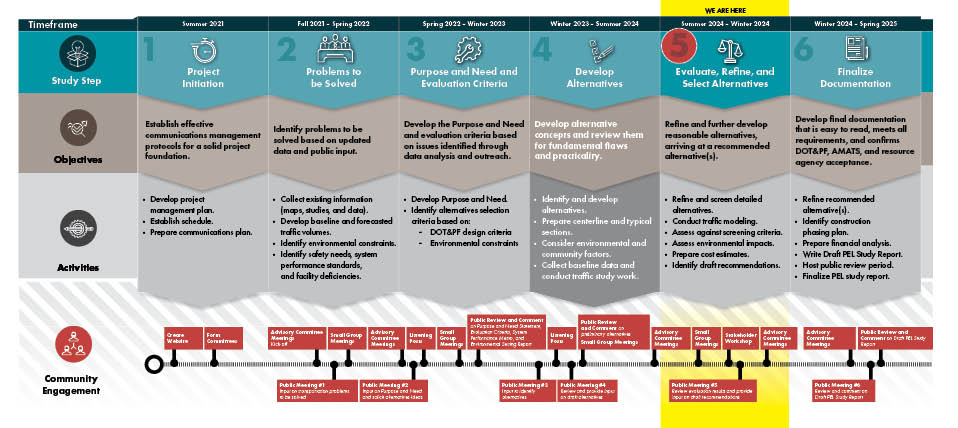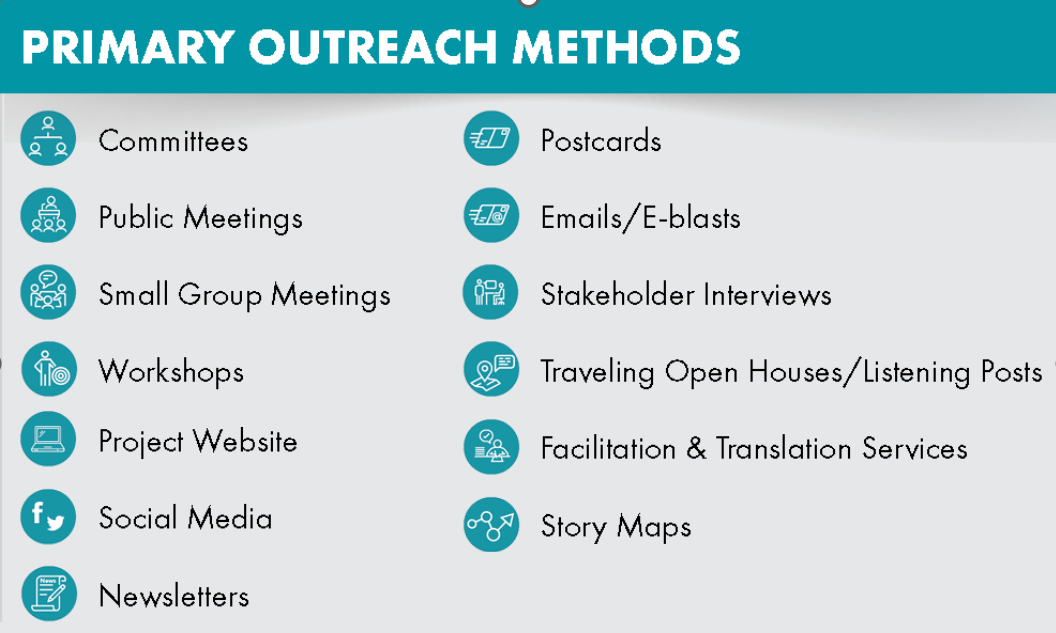Frequently Asked Questions

1. What is Seward to Glenn Connection PEL Study?
The Alaska Department of Transportation and Public Facilities (DOT&PF), Central Region, is conducting a Planning and Environmental Linkages (PEL) Study to consider potential transportation improvements in Anchorage, which will improve:
- Safety
- Livability
- Regional travel between the Seward and Glenn Highways
- Access between the interstate highway system and the Port of Alaska
- Local travel within the surrounding neighborhoods
The PEL Study process gives DOT&PF an opportunity to engage the community and stakeholders in identifying transportation needs, developing potential solutions, and narrowing down the list of alternatives that will be carried into future environmental review and design processes.
2. Who is conducting the Study?
DOT&PF manages the study in cooperation with the Anchorage Metropolitan Area Transportation Solutions (AMATS) staff. AMATS is the Metropolitan Planning Organization responsible for transportation planning for the Anchorage Bowl and Chugiak-Eagle River areas.
3. What are the limits of the study area?
The study area generally follows Bragaw Street on the east, Northern Lights on the south, C Street on the west, and Joint Base Elmendorf-Richardson on the north. It includes areas where potential transportation improvements could be developed between the Glenn and Seward Highways and to and from the Port of Alaska. The study area is broad enough also to gauge how traffic levels on parallel routes may be affected.
General Project Area

4. What is a Planning and Environmental Linkages (PEL) Study?
The study is being prepared as a PEL Study. According to the Federal Highway Administration (FHWA), a PEL Study represents a collaborative and integrated approach to transportation decision-making that (1) considers environmental, community, and economic goals early in the transportation planning process; and (2) uses the information, analysis, and products developed during planning to inform the environmental review process. See more at: Planning and Environment Linkages | Environmental Initiatives | Environmental Review Toolkit | FHWA (dot.gov). Learn more about the PEL process in this downloadable handout.
5. What are the potential benefits of a PEL Study?
The PEL process aids the transportation decision-making process. The PEL Study will:
- Identify potential benefits and impacts to communities, the environment, and the economy early in the planning stage, making the project more efficient and cost-effective.
- Engage partner agencies, stakeholders, and the public, building project awareness and support through transparent and consistent communication.
- Provide opportunities early and often for the public to provide input that shapes the project.
- Narrow down the range of project alternatives to carry into future environmental review, design work, and construction project steps.
Learn more about the PEL process in this downloadable handout.
6. What is the PEL Study schedule?
The PEL Study process began in June 2021 and is expected to conclude in 2025 (see Figure 2). Dates are subject to change.
Preliminary alternatives were offered for a 60-day public comment from February 7, 2024, through April 7, 2024. The project team has reviewed public comments and is in the process of refining alternatives with the intent to incorporate key learnings from the comment period. The team is additionally conducting traffic modeling and gathering other data, which will also affect refined alternative designs. Updated alternatives are expected to be made available for public review late in 2024.
Once the final PEL Study is complete, the project may move into additional environmental review and design through the National Environmental Policy Act (NEPA) process. Funding for construction projects would need to be included in the State Transportation Improvement Program if the projects identified in the PEL are to advance to construction.

Schedule Download 
7. What is the study’s background?
Connecting the Seward Highway to the Glenn Highway was discussed as early as 1972 in the Anchorage Long Range Transportation Plan (LRTP).
In 2001, AMATS conducted the East Anchorage Study of Transportation. It determined that connecting the Seward and Glenn Highways was important to solving traffic congestion in the Anchorage Bowl.
In 2005, the Seward Highway to Glenn Highway Connection (H2H) project was adopted as part of the Anchorage Bowl 2025 LRTP. DOT&PF started an environmental impact statement (EIS) process for the H2H project, but the EIS was canceled in 2010.
In 2020, recognizing the continuing need to address transportation in this corridor, DOT&PF adopted the PEL Study as part of the AMATS Metropolitan Transportation Plan (MTP) 2040.
8. What prompted the PEL Study?
The PEL Study is identified in MTP 2040, the adopted MTP for Anchorage. The plan indicates that the study intends to define a vision for a potential future highway connection, identify environmental and resource concerns and opportunities in the study area, and use the information to develop reasonable alternatives through consultation with the affected agencies and the public. This PEL Study is officially titled the Seward Highway to Glenn Highway Planning and Environmental Linkages Study (IRIS Program No. CFHWY00550 | Federal Project No. 0001653).
9. Haven't you already studied this project in the H2H EIS? Why are you studying it again?
DOT&PF started an EIS for the H2H project, but it was canceled in 2010. Connecting the Seward and Glenn Highways remains a priority in the AMATS MTP 2040. In a previous PEL Study (Midtown Congestion Relief PEL), DOT&PF re-evaluated the Midtown section of the H2H project along the Seward Highway (between Tudor Road and 20th Avenue). This current PEL Study is examining the area from 20th Avenue to Airport Heights Drive. Considerable time has gone by since 2010, when the need for connecting the Seward and Glenn Highways was last studied in detail. This study is re-examining the corridor’s transportation needs by looking at new traffic forecasts, new origin-destination travel studies, updated community and transportations plans, and other data. It will also examine potential alternatives and their impacts.
10. What has changed in the area since highway mobility needs and alternatives were last studied in detail?
When the project area was last studied in detail, the Knik Arm Crossing project and a viaduct roadway connecting Gambell/Ingra to the Port of Alaska were still part of the adopted transportation plan. Since then, economic conditions have been vastly different, and growth and land use development patterns are now subject to a newly adopted land use plan map. For these reasons, traffic patterns and congestion levels are anticipated to be different from those studied in 2010. It is important to re-examine the transportation needs in light of these and other changes to ensure that the improvements are addressing the existing needs.
11. What problems will the study examine?
The study is intended to address the following on the Seward to Glenn Highways:
To improve livability and local travel within the surrounding neighborhoods, the project team will conduct planning and environmental studies, perform traffic forecasting and travel demand modeling, and document the purpose and needs for any transportation improvements. Developed Alternatives will address identified problems based on engineering analyses. As a PEL Study, the efforts will integrate community and environmental factors into the decision-making process, with a strong emphasis on public involvement.
12. How will the study be used?
Once the final PEL Study is complete, a project (or components of the overall plan) may move forward for additional environmental review and engineering design through the NEPA process. The results of the study may also feed into a subsequent update of the MTP 2040, potentially updating needed improvements, cost estimates, and timing and phasing of improvements. Funding for construction projects would need to be included in the State Transportation Improvement Program if the projects identified through the PEL are to advance to construction.
13. How will the project team engage stakeholders and the public in the PEL process?
Feedback from the community and stakeholders is required by the PEL Study process and is central to the development of design alternatives. The project team will provide opportunities at each stage of the process for the public to learn about the study and provide input. See the image below for the main outreach methods we will use.
The process will involve many individuals and groups to inform the study, develop and screen alternatives, and review the Draft PEL Study Report. This includes agencies, Tribes, elected officials, utilities, emergency responders, businesses, nonprofits, community organizations, and the public.
We are committed to conducting a process that is equitable and responsive to the needs of traditionally underserved communities. This means:
- Providing accessible, inclusive, and convenient opportunities to engage.
- Reaching out to and integrating feedback from individuals and groups that are traditionally underserved and underrepresented by existing transportation systems.
- Communicating with the public regarding the feedback we have received.

14. How can I get involved?
Your input is important. Stay updated and share your thoughts by:
If you have questions, please reach out anytime to the project team at: